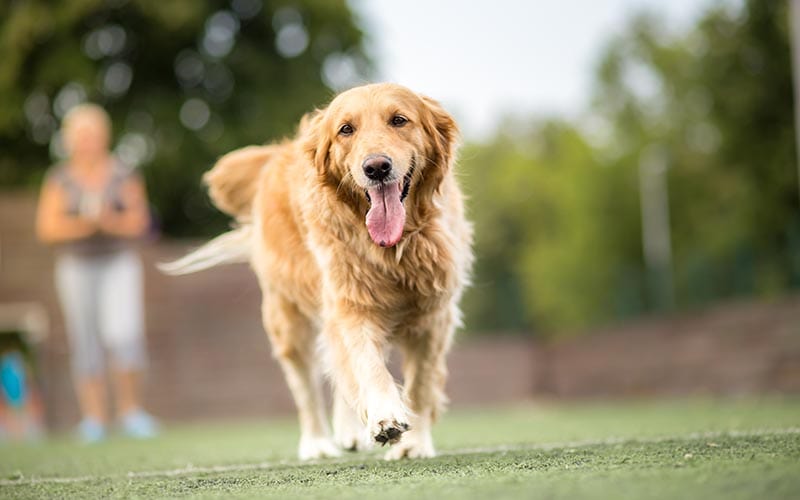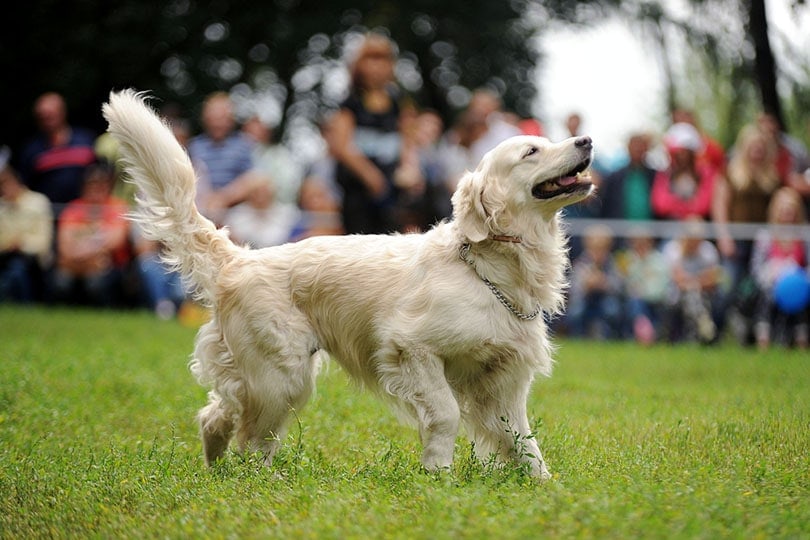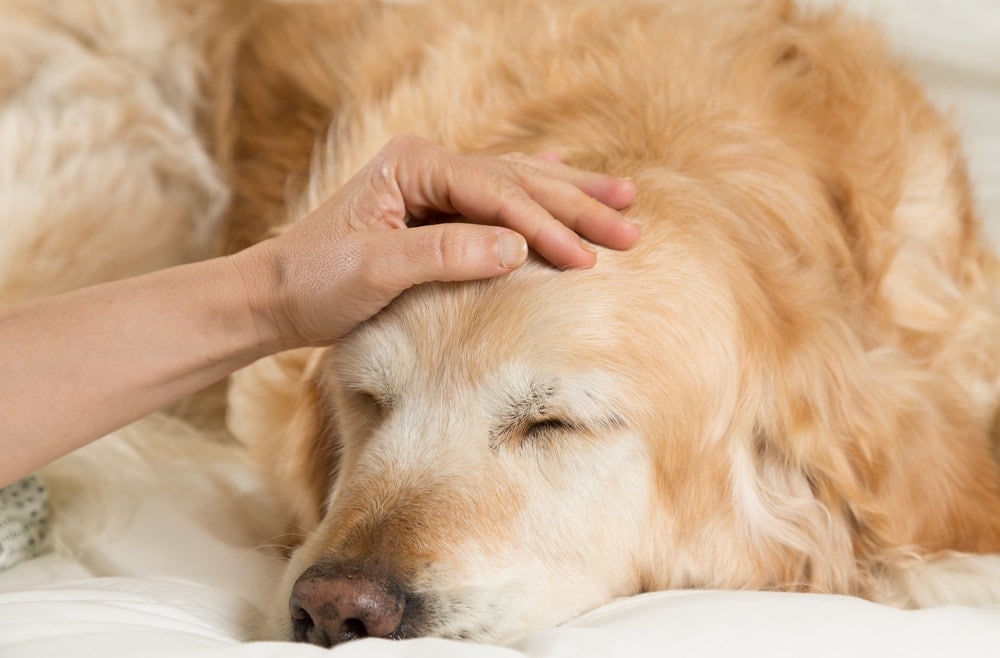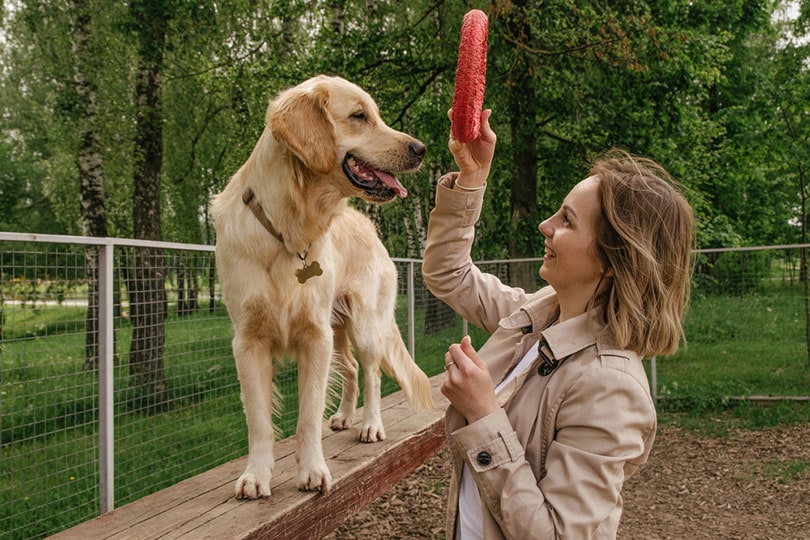Golden Retriever Hip Dysplasia: Our Vet Explains Signs, Causes & Care Guide
By Dr. Sharon Butzke, DVM (Vet)
Updated on

Click to Skip Ahead
Golden Retrievers consistently rank among the top five most popular dog breeds in the United States, according to the annual list published by the American Kennel Club (AKC). They are loveable, easy to train, and generally make wonderful family pets!
Unfortunately, they are also prone to hip dysplasia, a condition which primarily affects large breed dogs. Genetics play an important role in the development of hip dysplasia, but nutrition, exercise, and hormone levels during growth are also important factors.
Hip dysplasia leads to arthritis in the affected hip(s), and can significantly impact a dog’s quality of life. As a result, breeders of large breed dogs (including Golden Retrievers) often participate in screening programs that aim to reduce the number of dogs affected.
If you are thinking about adding a Golden Retriever to your family, it is a good idea to learn about hip dysplasia. Seek out breeders who screen their dogs for the condition, and consult your veterinarian for advice regarding the ideal nutrition and exercise for your growing puppy.
What is Hip Dysplasia?
The hip is commonly described as a “ball and socket” joint:
- The “ball” refers to the femoral head (top of the femur)
- The “socket” refers to the acetabulum (part of the pelvis)
In a normal hip joint, the acetabulum cradles the femoral head securely, allowing for smooth motion.
In dogs with hip dysplasia, the hip joint does not develop normally. The femoral head is often flattened instead of round, and the acetabulum is shallower than it should be. The result is a poor fit and a lax (i.e., loose) hip joint. Instead of rotating smoothly within the acetabulum, the femoral head bounces around, damaging cartilage and ultimately leading to arthritis.

What Are the Signs of Hip Dysplasia?
The signs of hip dysplasia are highly variable. They can range from a slightly abnormal gait to significant lameness (limping) and pain. If you notice any of these signs in your dog, please schedule an appointment with your veterinarian:
- Bunny hopping (i.e., moving the hind legs together)
- Limping (sometimes or all the time)
- Reduced muscle mass in one or both hind legs
- Difficulty getting up after sitting or lying down
- Reluctance to climb stairs or walk on slippery surfaces
- Decreased interest in physical activity
Owners are sometimes surprised when their veterinarian tells them that their dog is in pain. People often expect that a painful dog will whine or cry, but in fact this is not common (especially with chronic pain). This handout from the American Animal Hospital Association (AAHA) provides an excellent review of the many different (and often subtle) ways dogs show us they are experiencing pain.

What Are the Causes of Hip Dysplasia?
There is no single cause of hip dysplasia in dogs. Rather, multiple factors contribute to its development, including:
Genetics
Hip dysplasia is hereditary in dogs, but we do not fully understand the genes involved. Research is underway to identify specific genetic markers associated with the condition, which will hopefully lead to the development of a DNA-based test that can screen for hip dysplasia in Golden Retrievers and other breeds.
Currently, the only way to screen for hip dysplasia in breeding dogs is with hip radiographs (x-rays). In the United States, the Orthopedic Foundation for Animals (OFA) and the University of Pennsylvania Hip Improvement Plan (PennHip) assess radiographs based on clearly defined criteria. You can find a summary of a study comparing the two methods here.

Nutrition
Proper nutrition promotes normal growth and development in all puppies, but there are special considerations for large breeds. Ask your veterinarian to recommend an appropriate diet for your pup and how much you should be feeding at each meal. Free access to food during growth is not recommended, because it may be associated with an increased risk of hip dysplasia.
Exercise
Unfortunately, there are currently no established exercise protocols specifically for reducing the risk of hip dysplasia. However, a good general guideline is to never force a growing puppy to exercise. Puppies should be allowed to determine their own level of activity and take breaks when they get tired. Some experts also advise against letting puppies run around on slippery floors.

Timing of Spay or Neuter Surgery
In the past, many dogs in North America were spayed or neutered before one year of age (often as early as six months of age). However, recent studies have shown that this may increase the risk of certain health problems in large breed dogs (i.e., those weighing over 45 pounds at maturity).
With specific reference to Golden Retrievers, two studies performed at the University of California, Davis (published in 2013 and 2020) found significantly higher rates of hip dysplasia in male dogs neutered prior to 12 months of age, compared to intact males and those neutered after 12 months of age.
The timing of spay surgery appears to be less important for female Golden Retrievers, with respect to their risk of developing hip dysplasia.
How Do I Care for a Dog with Hip Dysplasia? 5 Ways to Help Your Pup
The primary goal when treating a dog with hip dysplasia is to alleviate discomfort and maintain a good quality of life. The condition can be managed in a variety of ways:
1. Surgical Treatment
There are four surgical options for treating hip dysplasia.
Two of the procedures address abnormal hip laxity in young dogs, and should be performed before arthritis has developed:
- Juvenile Pubic Symphysiodesis (JPS)
- Double or Triple Pelvic Osteotomy (DPO or TPO)
The other two procedures are recommended for dogs who already have arthritis in their affected hip(s):
- Total Hip Replacement (THR)
- Femoral Head Ostectomy (FHO)
Detailed explanations of these procedures (and when they are indicated) can be found in the ‘Treatment’ section of this article by the American College of Veterinary Surgeons (ACVS).
2. Pain Management
Non-steroidal anti-inflammatory drugs (NSAIDs) are commonly used to manage pain in dogs with arthritis. Most are well-tolerated and safe for long-term use in dogs with adequate liver and kidney function. Other pain medications may be used if needed, either in conjunction with an NSAID or as an alternative.

3. Weight Management
Maintenance of a lean body weight has been shown to reduce pain in dogs with hip dysplasia and will also help with mobility.
4. Physical Therapy
Physiotherapy and other forms of physical rehabilitation are often recommended for dogs recovering from hip dysplasia surgery. They can also help maintain strength and mobility for dogs who do not receive surgical treatment.

5. Nutraceuticals and Alternative Therapies
There are a wide variety of supplements and alternative treatments available to help manage arthritis in dogs, which are described in detail here.
Frequently Asked Questions
How common is hip dysplasia in Golden Retrievers?
The exact incidence of hip dysplasia in Golden Retrievers in the United States is unknown. A study published in 2005 estimated that 53-73% of Golden Retrievers could be affected by hip dysplasia, but this estimate may be conservative.
Can hip dysplasia be prevented?
Unfortunately, not all cases of hip dysplasia can be prevented. The best we can do is:
- Screen dogs prior to breeding
- Provide appropriate nutrition and exercise for growing large breed puppies
- Wait until a year of age or older to neuter male Golden Retrievers
How is hip dysplasia diagnosed?
Hip dysplasia is diagnosed by:
- Observation of the dog’s gait and manipulation of their hips to check for the Ortolani sign (which confirms hip laxity); this test should be performed under sedation and only by a trained veterinarian
- Radiographs (x-rays) of the hips, which should also be performed under sedation (or even anesthesia) to prevent discomfort and ensure proper positioning
Conclusion
A diagnosis of hip dysplasia can be devastating for owners, and can significantly impact a dog’s quality of life. If you are thinking about adding a Golden Retriever to your family, please choose a breeder who screens for this condition. While screening cannot guarantee your puppy won’t inherit hip dysplasia, it is one of the best tools we have for now. Hopefully, a genetic test will be available in the future to help reduce the number of dogs affected by this condition.
See Also:
- When to Spay or Neuter a Golden Retriever? Vet-Reviewed Practices & Tips
- 15 Popular Large Dog Breeds (With Pictures)
Featured Image Credit: Lunja, Shutterstock











